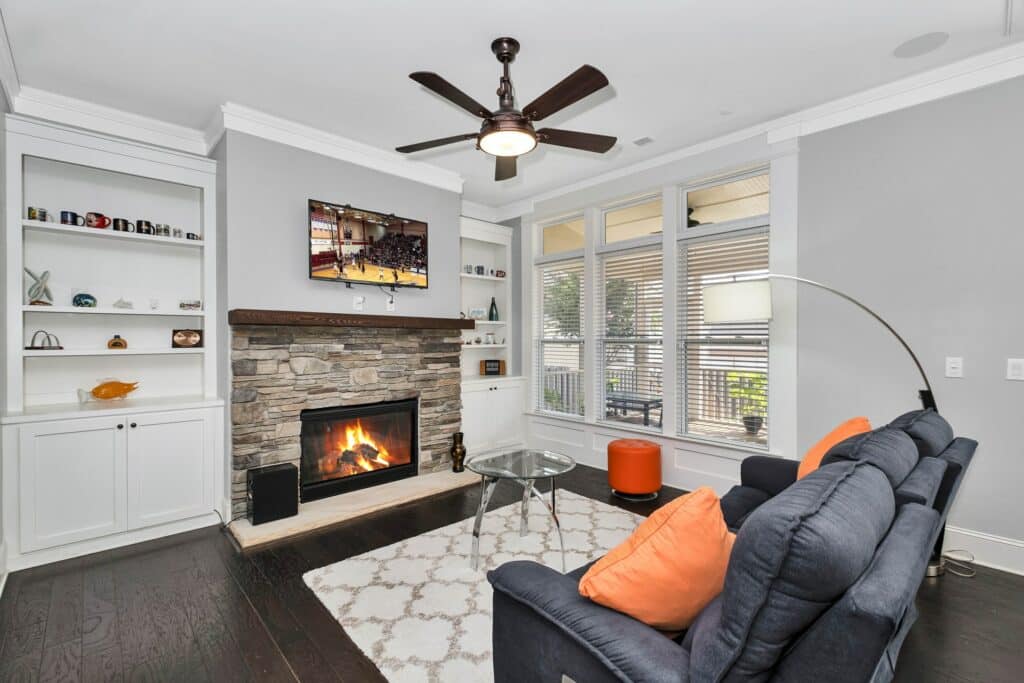Did you buy or inherit a house with a fireplace you aren’t sure how to use? There are certain steps you should take to help ensure the safety of your family and your fireplace. We’ve created this guide to help you do exactly that.
1. Know what type of fireplace it is
Wood Burning
The first thing you want to look at on your wood-burning fireplace is the firebox. Take a flashlight and look for any gaping between the bricks or cracks in the mortar. If you see these things, it might be best to have a professional look at it for you.
If you have never used a wood-burning fireplace before, here’s how to do it:
Step 1: Open the chimney damper
You will want to open the chimney damper before each use and close it after each use. This allows smoke to escape into the chimney as you burn the wood. Keeping it closed when not in use will prevent warm air from escaping.
Step 2: Select your firewood
Only use wood that has been seasoned for at least 6 months, or else it will be too wet to burn properly. Do not use pine wood in your fireplace because it can cause creosote build-up – which puts your home at risk for chimney fires. Use a mixture of both hardwoods and softwoods.
Step 3: Start the fire
Line the bottom of your fireplace grate with softwood and layer the hardwood on top. Then, place fire starter logs underneath the grate and light them. These logs ignite the softwoods which then ignite the hardwoods that burn longer.
Step 4: Feed the fire
Add hardwood logs at regular intervals to feed the fire depending on how large your fire is and how long you want it to burn.
Step 5: Aftercare
Once the fire is completely out, remove the ashes with a fireplace shovel and discard them in a metal bucket. Now, close the damper and close the fireplace doors (or add a shield) to keep your warm air from escaping.
Gas
Gas fireplaces are a more modern type of fireplace. Gas fireplaces often have real-looking logs with mock flames to add a touch of authenticity. If you know (or suspect) that your home has a gas fireplace, the most important thing to check is your carbon monoxide detectors. Ensure that they have fresh batteries and change the batteries routinely to maintain proper functioning.
With gas fireplaces, it is critical that you call a professional to get an inspection or assistance before adjusting or changing anything. The smallest change (even if it’s an accidental change) to the gas intake in your home could pose serious risks to you, your family, & other gas appliances in your home.
Learn more in our guide to gas fireplaces!
Electric
Electric fireplaces produce no flames and are generally low maintenance. These are great for homes that don’t have existing fireplaces. The previous owner may have left you a manual for the fireplace, which is great! If not, you may be able to see a name or model number on the fireplace. You may be able to look up the manual or instructions for it.
2. Find out about its usage
When you know how the previous owner cared for the fireplace, you will know what decisions to make about any maintenance that may need to happen immediately. And, you’ll know what maintenance to schedule for the following year.
If the fireplace was used often, there may be creosote built up in the flue. This is especially true if the previous owner didn’t take good care of it. Fireplaces that are used regularly but not cleaned regularly are good candidates for creosote buildup and masonry damage.
Fireplaces that haven’t been used regularly can have some unwanted critters who have taken up residency. So, whether your fireplace was regularly used or not used at all, it’s still important to have a yearly cleaning & inspection. The same is true for gas fireplaces, as well, just to make sure all of their components are working properly.
3. Understand maintenance requirements
Keeping your home safe is directly affected by the proper maintenance of your fireplace. Safety and maintenance guidelines will vary depending on the type of fireplace you have, and those are as follows:
- The NFPA (National Fire Protection Association) handbook outlines that a wood-burning fireplace should be inspected once a year to see if it needs to be swept out and to check for any defects.
- Vented gas logs should be cleaned yearly due to soot build-up. Vent-free gas logs should be checked yearly to ensure proper functioning.
- Unless they break, there’s almost no need to have an electric fireplace serviced
Find out more details about each of these in our guide to fireplace servicing.
4. Get an inspection or consult a professional
An inspection is one of the most important parts of buying a new home. Obvious signs of fireplace issues can be caught by a general home inspector but a CSIA-certified chimney sweep should take a closer look at the entire fireplace and chimney. This will reduce the risk of critical safety issues or needed repairs being missed. If you have any questions about the age, condition, and operation of your fireplace, Bassemiers is here to help! Contact us today!






























